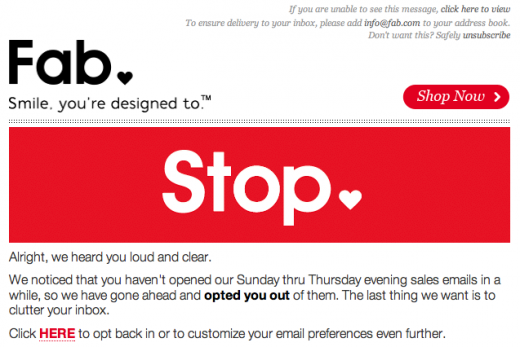I‘ve been running HubSpot’s Marketing Daily emails for about as long as I've been with the company (a slight nudge for you to subscribe), so I know a thing or two about getting your marketing emails to the right inbox.
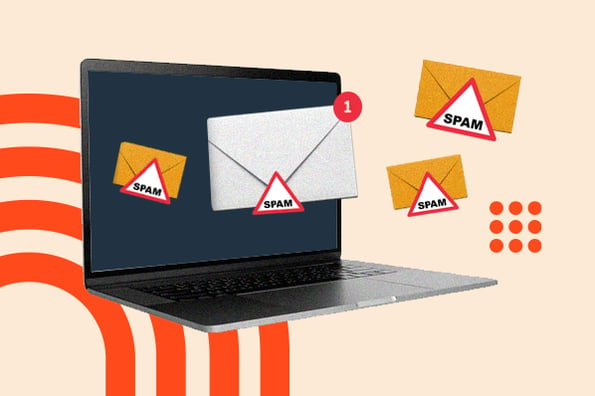
I also know a lot about avoiding spam trigger words and filters. Though avoiding trigger words isn‘t enough to evade the robust systems of spam filters, it’s good to know them to keep your marketing emails in good standing with email providers like Google Mail.
To ensure your marketing emails reach your target audience, here‘s a list of spam trigger words and habits to steer clear of in your messages. But first, let’s get into the details of spam trigger words.
Spam List: Words to Avoid When Possible
What are spam trigger words?
Spam trigger words are keywords and phrases that alert email providers that a message could likely be spam. Emails containing these words would then be sorted into the dreaded email graveyard that is your inbox's spam folder — never to see the light of day again.
Some spam trigger words are easier to avoid in marketing emails than others. For example, you don't have to refer to your email recipients as “dear” in your marketing emails (in fact, you shouldn't).
However, avoiding specific calls to action like “Act now!” or “Discount” could be difficult, primarily if you sell products and services.
Fortunately, spam trigger words aren't as relevant as they used to be now that inbox service providers (ISPs) have more sophisticated methods of determining if an email is spam.
That said, I strongly urge you to be aware of words and phrases to avoid (or use sparingly) to ensure your emails reach your target recipients and avoid spam folders.
How to Avoid the Spam Folder
Here are some tips to help you protect your brand's reputation and ensure your emails reach the inbox.
1. Send targeted content to those who have asked to receive it.
In my experience, sending marketing emails to contacts who have consented will result in positively engaged mail.
It’s also essential to send mail that contacts are expecting to receive.
For example, I only send Marketing Blog Daily emails to contacts subscribed to receive them. I do not send them to our weekly email subscribers. Contacts requesting a weekly newsletter may engage negatively if they’re emailed daily.
This may include leaving it unopened or taking more drastic measures like unsubscribing or marking it as spam.
In addition to obtaining consent and being thoughtful with outreach, I also suggest protecting a strong reputation by not sending materials to those who have stopped engaging with your emails.
It’s normal for lists to depreciate and for contacts to become unengaged. It’s important to start thoughtfully suppressing unengaged contacts before they start dragging down engagement rates and impacting reputation.
This strategy is often accompanied by a sunset policy, a plan for managing contacts that have stopped engaging.
Pro-Tip: Always include a visible unsubscribe link in your emails. This will help avoid spam triggers and will help ensure your recipients are choosing to still remain subscribed.

2. Use the same name for every email.
I always include the same sender name for every HubSpot Marketing email I send: HubSpot Blog, Marketing. Spammers will often change their sender name between emails to confuse recipients.
So, ensure your sender name is consistent and authentic so you don‘t get lumped in with the fakers. Be authentic by using your company name, brand name, or person’s name.
3. Be mindful of your email's content.
Include your business' physical address so spam filters can confirm your authenticity. Also, keep a balanced ratio of images and texts, and avoid using just one large image or too many in your marketing emails.
For example, my HubSpot Marketing emails consist of 3 medium-sized featured images split up by headings and short body paragraphs.

4. Authenticate your brand’s marketing emails.
DMARC, SPF, and DKIM are means of authentication, and all are considered best practices.
Adding authentication to your brand’s sends won’t reverse negative reputation impact or ensure that mail is delivered to a primary inbox. Still, it can improve the trust recipients’ mail servers have in your mail.
You should also take steps to protect your brand’s sending reputation by regularly monitoring the following metrics:
Open Rate
Low opens indicate a need for unengaged contact suppression or that your sending reputation has been negatively impacted.
Click-through Rate
Low click-through rates can mean an opportunity for better segmentation or clearer CTAs.
Hard Bounce Rate
A high hard bounce can indicate that a list is outdated, although reading the bounce message will be the best way to diagnose bounce issues.
Unsubscribe Rate
A high unsubscribe rate can also mean that a list is stale or that contacts are being sent something they didn’t subscribe to.
Spam Compliant Rate
A high spam complaint rate is always a reason for pause, as that’s a strong indicator that contacts weren’t expecting mail from your brand.
Spam complaints are taken seriously by inbox service providers (ISP) and can negatively impact your brand’s sending reputation quickly.
.png)
A Beginner's Guide to Email Marketing
How to execute and measure successful email marketing campaigns
- Growing an email list.
- Remaining CAN-SPAM compliant.
- Using email automation.
- Segmenting your audience.
5. Avoid the abnormal.
ISPs are looking for senders to remain as “normal” as possible from send to send — of course, “normal” is a relative term.
In general, sending to the same audiences (with the necessary segmentation) and avoiding large volume spikes can help your brand avoid the abnormal.
Knowing what you’re linking to can also help avoid the spam folder.
Just like how your brand’s reputation can dictate whether or not your mail is delivered to a primary inbox (not spam, junk, or other filtered inboxes), websites you link to carry their reputation.
Sharing a link to an external website with a poor reputation can make your mail more likely to bounce or get filtered out.
For this very reason, I only link to other HubSpot content in my marketing emails.
Speaking of abnormalities, avoid making unrealistic promises or claims (more on that later).
6. Comply with local email regulations.
Whether it’s GDPR, CAN-SPAM, CCPA, CASL, or one of the many other local regulations, complying with these local requirements will be vital to a successful mail strategy.
You must comply with the regulations and your email-sending platform's requirements (ESP). This protects you as a sender (violating local regulations can have ramifications) and allows you to treat your contacts the way they expect to be treated based on their location.
Spamming Examples
Here are two examples of spam emails I‘ve found in my inbox. Notice how the first one is vague and only mentions a "proposal" and a "client." This is obvious spam, and you probably think, "I’d never send a marketing email that looks like!"

I trust you wouldn‘t, but the vague messaging is one of many reasons it’s in the spam folder. There‘s no mention of the business’ name, physical address, or purpose.
There also isn't an unsubscribe button.
Notice the second example below. This one mentions that I have a podcast, which is true. But it doesn‘t say it by name, and it’s making unrealistic promises to get my content to rank on YouTube in just 5 minutes. Unrealistic claims are red flags for spam filters.
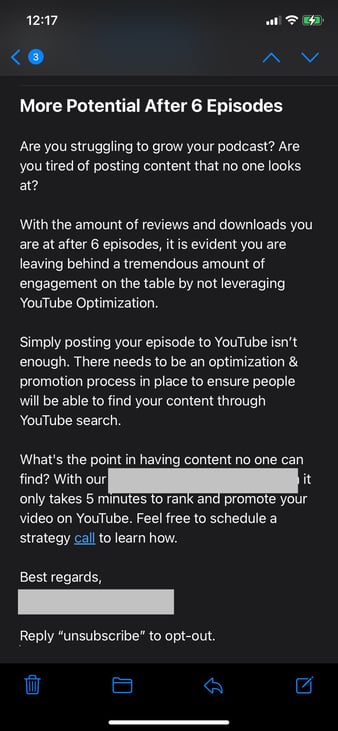
Furthermore, instead of including an unsubscribe link, the email urges recipients to respond to unsubscribe. When it comes to spam emails, engaging at all is risky. So, the best thing to do is not reply, especially if there isn't a simple link to unsubscribe.
Spam List: Words to Avoid When Possible
As I said, some words and phrases are easier to avoid than others. At the very least, you'll want to ensure you use some of these only if you absolutely need to and as little as possible.
Commerce
- As seen on
- Buy
- Buy direct
- Buying judgments
- Clearance
- Order
- Order status
- Orders shipped by shopper
Personal
- Dig up dirt on friends
- Meet singles
- Score with babes
- XXX
- Near you
Employment
- Additional income
- Be your own boss
- Compete for your business
- Double your
- Earn $
- Earn extra cash
- Earn per week
- Expect to earn
- Extra income
- Home-based
- Home employment
- Home-based business
- Income from home
- Make $
- Make money
- Money making
- Online biz opportunity
- Online degree
- Opportunity
- Potential earnings
- University diplomas
- While you sleep
- Work at home
- Work from home
.png)
A Beginner's Guide to Email Marketing
How to execute and measure successful email marketing campaigns
- Growing an email list.
- Remaining CAN-SPAM compliant.
- Using email automation.
- Segmenting your audience.
Financial - General
- $$$
- Affordable
- Bargain
- Beneficiary
- Best price
- Big bucks
- Cash
- Cash bonus
- Cashcashcash
- Cents on the dollar
- Cheap
- Check
- Claims
- Collect
- Compare rates
- Cost
- Credit
- Credit bureaus
- Discount
- Earn
- Easy terms
- F r e e
- Fast cash
- For just $XXX
- Hidden assets
- hidden charges
- Income
- Incredible deal
- Insurance
- Investment
- Loans
- Lowest price
- Million dollars
- Money
- Money back
- Mortgage
- Mortgage rates
- No cost
- No fees
- One hundred percent free
- Only $
- Pennies a day
- Price
- Profits
- Pure profit
- Quote
- Refinance
- Save $
- Save big money
- Save up to
- Serious cash
- Subject to credit
- They keep your money — no refund!
- Unsecured credit
- Unsecured debt
- US dollars
- Why pay more?
Financial - Business
- Accept credit cards
- Cards accepted
- Check or money order
- Credit card offers
- Explode your business
- Full refund
- Investment decision
- No credit check
- No hidden Costs
- No investment
- Requires initial investment
- Sent in compliance
- Stock alert
- Stock disclaimer statement
- Stock pick
Financial - Personal
- Avoid bankruptcy
- Calling creditors
- Collect child support
- Consolidate debt and credit
- Consolidate your debt
- Eliminate bad credit
- Eliminate debt
- Financially independent
- Get out of debt
- Get paid
- Lower interest rate
- Lower monthly payment
- Lower your mortgage rate
- Lowest insurance rates
- Pre-approved
- Refinance home
- Social security number
- Your income
General
- Acceptance
- Accordingly
- Avoid
- Chance
- Dormant
- Freedom
- Here
- Hidden
- Home
- Leave
- Lifetime
- Lose
- Maintained
- Medium
- Miracle
- Never
- Passwords
- Problem
- Remove
- Reverses
- Sample
- Satisfaction
- Solution
- Stop
- Success
- Teen
- Wife
.png)
A Beginner's Guide to Email Marketing
How to execute and measure successful email marketing campaigns
- Growing an email list.
- Remaining CAN-SPAM compliant.
- Using email automation.
- Segmenting your audience.
Greetings
- Dear [email/friend/somebody]
- Friend
- Hello
Marketing
- Ad
- Auto email removal
- Bulk email
- Click
- Click below
- Click here
- Click to remove
- Direct email
- Direct marketing
- Email harvest
- Email marketing
- Form
- Increase sales
- Increase traffic
- Increase your sales
- Increase visibility
- Internet market
- Internet marketing
- Marketing
- Marketing solutions
- Mass email
- Member
- Month trial offer
- More Internet Traffic
- Multi-level marketing
- Not spam
- One time mailing
- Online marketing
- Open
- Opt-in
- Performance
- Removal instructions
- Sale
- Sales
- Search engine listings
- Search engines
- Subscribe
- The following form
- This isn't junk
- This isn't spam
- Undisclosed recipient
- Unsubscribe
- Visit our website
- We hate spam
- Web traffic
- Will not believe your eyes
Medical
- Cures baldness
- Diagnostic
- Fast Viagra delivery
- Human growth hormone
- Life insurance
- Lose weight
- Lose weight spam
- Medicine
- No medical exams
- Online pharmacy
- Removes wrinkles
- Reverses aging
- Stop snoring
- Valium
- Viagra
- Vicodin
- Weight loss
- Xanax
Numbers
- #1
- 100% free
- 100% satisfied
- 4U
- 50% off
- Billion
- Billion dollars
- Join millions
- Join millions of Americans
- Million
- One hundred percent guaranteed
- Thousands
Offers
- Being a member
- Billing address
- Call
- Cannot be combined with any other offer
- Confidentially on all orders
- Deal
- Financial freedom
- Gift certificate
- Giving away
- Guarantee
- Have you been turned down?
- If only it were that easy
- Important information regarding
- In accordance with laws
- Long-distance phone offer
- Mail in order form
- Message contains
- Name brand
- Nigerian
- No age restrictions
- No catch
- No claim forms
- No disappointment
- No experience
- No gimmick
- No inventory
- No middleman
- No obligation
- No purchase necessary
- No questions asked
- No selling
- No strings attached
- No-obligation
- Not intended
- Obligation
- Offshore
- Offer
- Per day
- Per week
- Priority mail
- Prize
- Prizes
- Produced and sent out
- Reserves the right
- Shopping spree
- Stuff on sale
- Terms and conditions
- The best rates
- They’re just giving it away
- Trial
- Unlimited
- Unsolicited
- Vacation
- Vacation offers
- Warranty
- We honor all
- Weekend getaway
- What are you waiting for?
- Who really wins?
- Win
- Winner
- Winning
- Won
- You are a winner!
- You have been selected
- You’re a Winner!
Calls-to-Action
- Cancel at any time
- Compare
- Copy accurately
- Get
- Give it away
- Print form signature
- Print out and fax
- See for yourself
- Sign up free today
.png)
A Beginner's Guide to Email Marketing
How to execute and measure successful email marketing campaigns
- Growing an email list.
- Remaining CAN-SPAM compliant.
- Using email automation.
- Segmenting your audience.
Free
- Free
- Free access
- Free cell phone
- Free consultation
- Free DVD
- Free gift
- Free grant money
- Free hosting
- Free installation
- Free Instant
- Free investment
- Free leads
- Free membership
- Free money
- Free offer
- Free preview
- Free priority mail
- Free quote
- Free sample
- Free trial
- Free website
Descriptions/Adjectives
- All natural
- All new
- Amazing
- Certified
- Congratulations
- Drastically reduced
- Fantastic deal
- For free
- Guaranteed
- It’s effective
- Outstanding values
- Promise you
- Real thing
- Risk free
- Satisfaction guaranteed
Sense of Urgency
- Access
- Act now!
- Apply now
- Apply online
- Call free
- Call now
- Can't live without
- Do it today
- Don't delete
- Don't hesitate
- For instant access
- For Only
- For you
- Get it now
- Get started now
- Great offer
- Info you requested
- Information you requested
- Instant
- Limited time
- New customers only
- Now
- Now only
- Offer expires
- Once in lifetime
- One time
- Only
- Order now
- Order today
- Please read
- Special promotion
- Supplies are limited
- Take action now
- Time limited
- Urgent
- While supplies last
Nouns
- Addresses on CD
- Beverage
- Bonus
- Brand new pager
- Cable converter
- Casino
- Celebrity
- Copy DVDs
- Laser printer
- Legal
- Luxury car
- New domain extensions
- Phone
- Rolex
- Stainless steel
Building Your Brand's Reputation
While, unfortunately, simply avoiding a list of words won’t keep you out of the spam folder, you can still take steps to protect your brand’s reputation and work towards solid deliverability. Good luck!
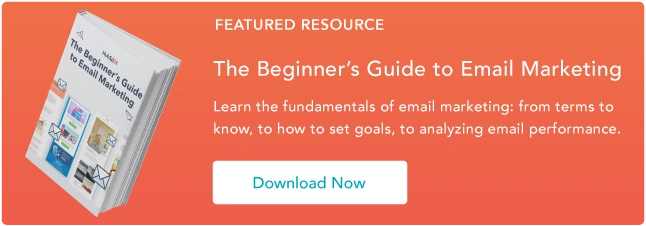
![→ Download Now: The Beginner's Guide to Email Marketing [Free Ebook]](https://no-cache.hubspot.com/cta/default/53/53e8428a-29a5-4225-a6ea-bca8ef991c19.png)
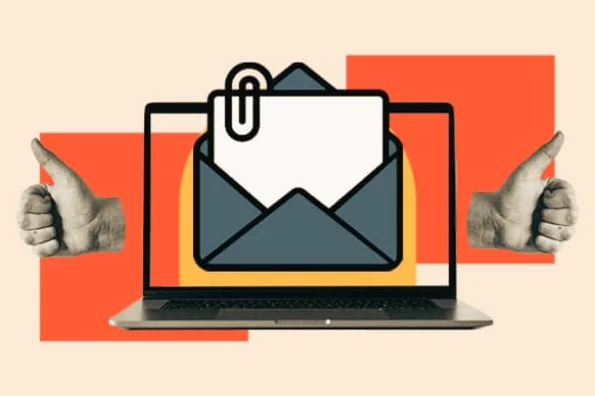

![Email Deliverability: 5 Quick & Effective Ways to Increase It [+IG]](https://blog.hubspot.com/hubfs/email-deliverability-1.jpg)



![The Difference Between Hard Bounces and Soft Bounces [FAQs]](https://blog.hubspot.com/hs-fs/hub/53/file-2636343432-png/00-Blog_Thinkstock_Images/bounce-rate-crush.png)
![What Is CAN-SPAM? [FAQs]](https://blog.hubspot.com/hs-fs/hub/53/file-285821426-jpg/Blog-Related_Images/canspam-explanation.jpg)
